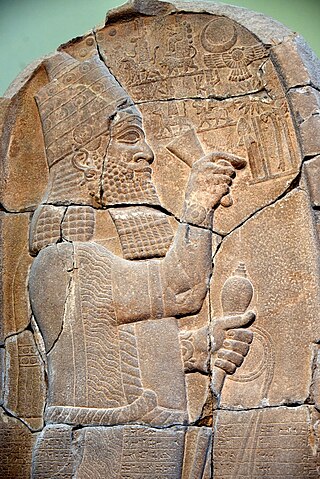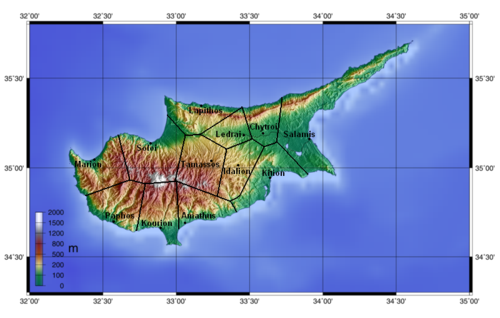
The 7th century BC began the first day of 700 BC and ended the last day of 601 BC.
Tarshish occurs in the Hebrew Bible with several uncertain meanings, most frequently as a place far across the sea from Phoenicia and the Land of Israel. Tarshish was said to have exported vast quantities of important metals to Phoenicia and Israel. The same place name occurs in the Akkadian inscriptions of the Neo-Assyrian emperor Esarhaddon and also on the Phoenician inscription of the Nora Stone in Sardinia; its precise location was never commonly known, and was eventually lost in antiquity. Legends grew up around it over time, so its identity has been the subject of scholarly research and commentary for more than two thousand years.

Esarhaddon, also spelled Essarhaddon, Assarhaddon and Ashurhaddon was the king of the Neo-Assyrian Empire from 681 BC to 669 BC. The third king of the Sargonid dynasty, Esarhaddon is most famous for his conquest of Egypt in 671 BC, which made his empire the largest the world had ever seen, and for his reconstruction of Babylon, which had been destroyed by his father.

Baal I was a king of Tyre. His name is the same as that of the Phoenician deity, Baal. He was tributary to the Assyrians, who had conquered the rest of Phoenicia.

Idalion or Idalium was an ancient city in Cyprus, in modern Dali, Nicosia District. The city was founded on the copper trade in the 3rd millennium BC. Its name does not appear, however, on the renowned "Kition Stele", i.e., the Sargon Stele of 707 BC, but a little later on the Prism of Esarhaddon known as Niniveh A wherein the name is prefixed by the modifier URU (city) as URU.e-di-ʾi-il and in similar spellings in Ashurbanipal's annal while modified by KUR (land/kingdom).
Madyes was a Scythian king who ruled during the period of the Scythian presence in West Asia in the 7th century BCE.

Ḫiyawa or Adanawa was a Luwian-speaking Syro-Hittite state which existed in southeastern Anatolia in the Iron Age.

Baalshamin, also called Baal Shamem and Baal Shamaim, was a Northwest Semitic god and a title applied to different gods at different places or times in ancient Middle Eastern inscriptions, especially in Canaan/Phoenicia and Syria. The title was most often applied to Hadad, who is also often titled just Ba‘al. Baalshamin was one of the two supreme gods and the sky god of pre-Islamic Palmyra in ancient Syria. There his attributes were the eagle and the lightning bolt, and he perhaps formed a triad with the lunar god Aglibol and the sun god Malakbel. The title was also applied to Zeus.
Onesilus or Onesilos was the brother of king Gorgos (Gorgus) of the Greek city-state of Salamis on the island of Cyprus. He is known only through the work of Herodotus.

Dali is a town in Cyprus, located south east of the capital Nicosia and close to the ancient city of Idalion. In 2001, it had a population of 5,834. By 2011, the population had almost doubled to 10,466.

Sidon's Sea Castle was built by the crusaders in the thirteenth century as a fortress of the Holy Land. It is one of the most prominent historical sites in the port city of Sidon, Lebanon.

During the Middle Assyrian Empire and the Neo-Assyrian Empire, Phoenicia, what is today known as Lebanon and coastal Syria, came under Assyrian rule on several occasions.

Abdi-Milkutti was a King of Sidon who rose up against Assyrian rule. He had formed an alliance with Sanduarri, king of Kundi and Sizu, a prince of the Lebanon, probably during the time of the civil war waged between Esarhaddon and two of his brothers who disputed his succession after they had murdered his father. The two kings had sworn to each other by the names of the great gods and revolted. As soon as this struggle was over, in response to the rebellion, Esarhaddon laid siege to Sidon, which after three years of siege, in 677 BC, was finally captured, destroyed and rebuilt as Kar-Ashur-aha-iddina, the Harbour of Esarhaddon. The Sidonian king was decapitated. Sanduarri was also captured and decapitated and the heads of the two kings were hung around the necks of their nobles who were paraded through the streets of Nineveh. Part of the treasure taken from Sidon went to the loyal king of the rival city Tyre.

The Temple of Eshmun is an ancient place of worship dedicated to Eshmun, the Phoenician god of healing. It is located near the Awali river, 2 kilometres (1.2 mi) northeast of Sidon in southwestern Lebanon. The site was occupied from the 7th century BC to the 8th century AD, suggesting an integrated relationship with the nearby city of Sidon. Although originally constructed by Sidonian king Eshmunazar II in the Achaemenid era to celebrate the city's recovered wealth and stature, the temple complex was greatly expanded by Bodashtart, Yatonmilk and later monarchs. Because the continued expansion spanned many centuries of alternating independence and foreign hegemony, the sanctuary features a wealth of different architectural and decorative styles and influences.
Bartatua or Protothyes was a Scythian king who ruled during the period of the Scythian presence in Western Asia in the 7th century BCE.
Išpakāya was a Scythian king who ruled during the period of the Scythian presence in Western Asia in the 7th century BCE.

The Phoenicians were an ancient Semitic group of people who lived in the Phoenician city-states along a coastal strip in the Levant region of the eastern Mediterranean, primarily modern Lebanon. They developed a maritime civilization which expanded and contracted throughout history, with the core of their culture stretching from Arwad in modern Syria to Mount Carmel. The Phoenicians extended their cultural influence through trade and colonization throughout the Mediterranean, from Cyprus to the Iberian Peninsula, evidenced by thousands of Phoenician inscriptions.

Ḫilakku, later known as Pirindu, was a Luwian-speaking Syro-Hittite state which existed in southeastern Anatolia in the Iron Age.
The Kings of Byblos were the rulers of Byblos, the ancient Phoenician city in what is now Lebanon.
Eshmunazar I was a priest of Astarte and the Phoenician King of Sidon. He was the founder of his namesake dynasty, and a vassal king of the Achaemenid Empire. Eshmunazar participated in the Neo-Babylonian campaigns against Egypt under the command of either Nebuchadnezzar II or Nabonidus. The Sidonian king is mentioned in the funerary inscriptions engraved on the royal sarcophagi of his son Tabnit I and his grandson Eshmunazar II. The monarch's name is also attested in the dedicatory temple inscriptions of his other grandson, King Bodashtart.












